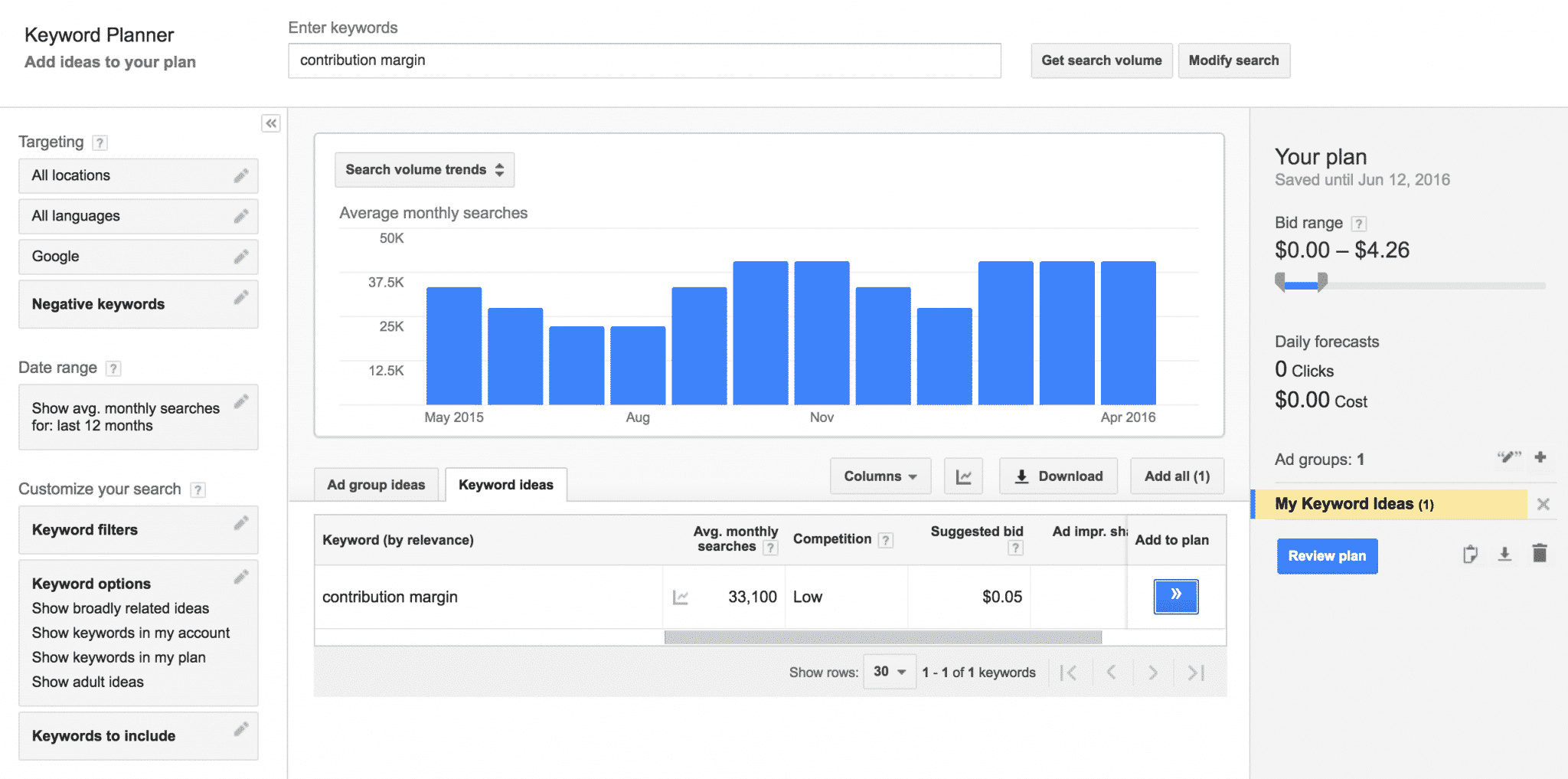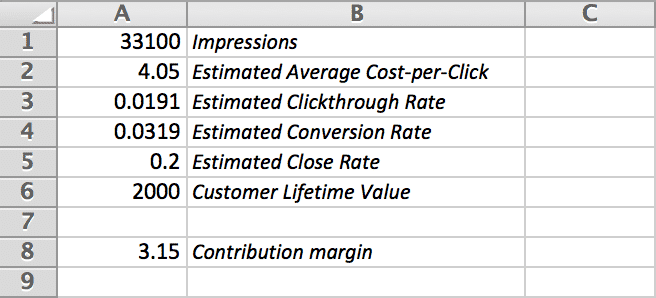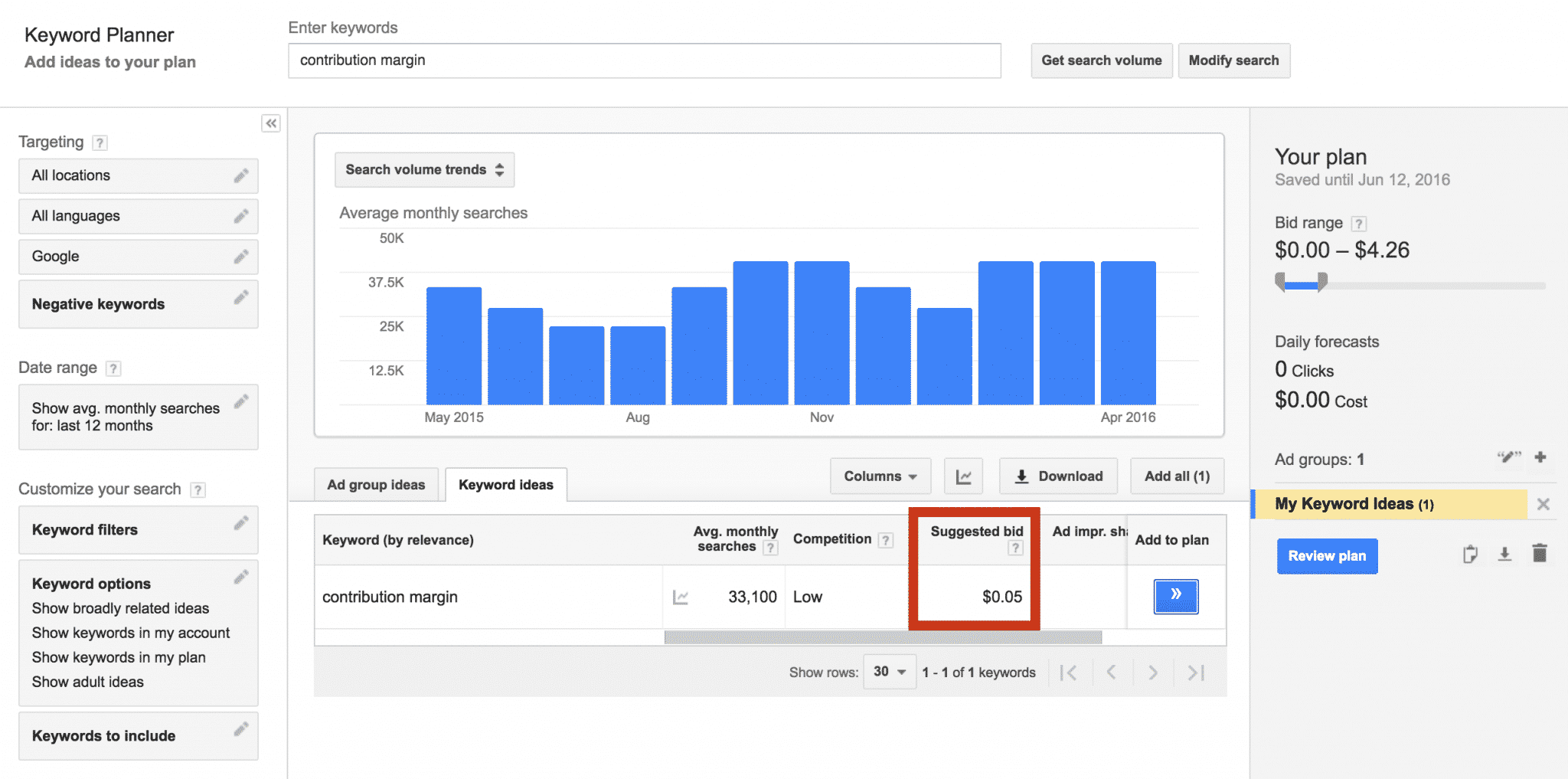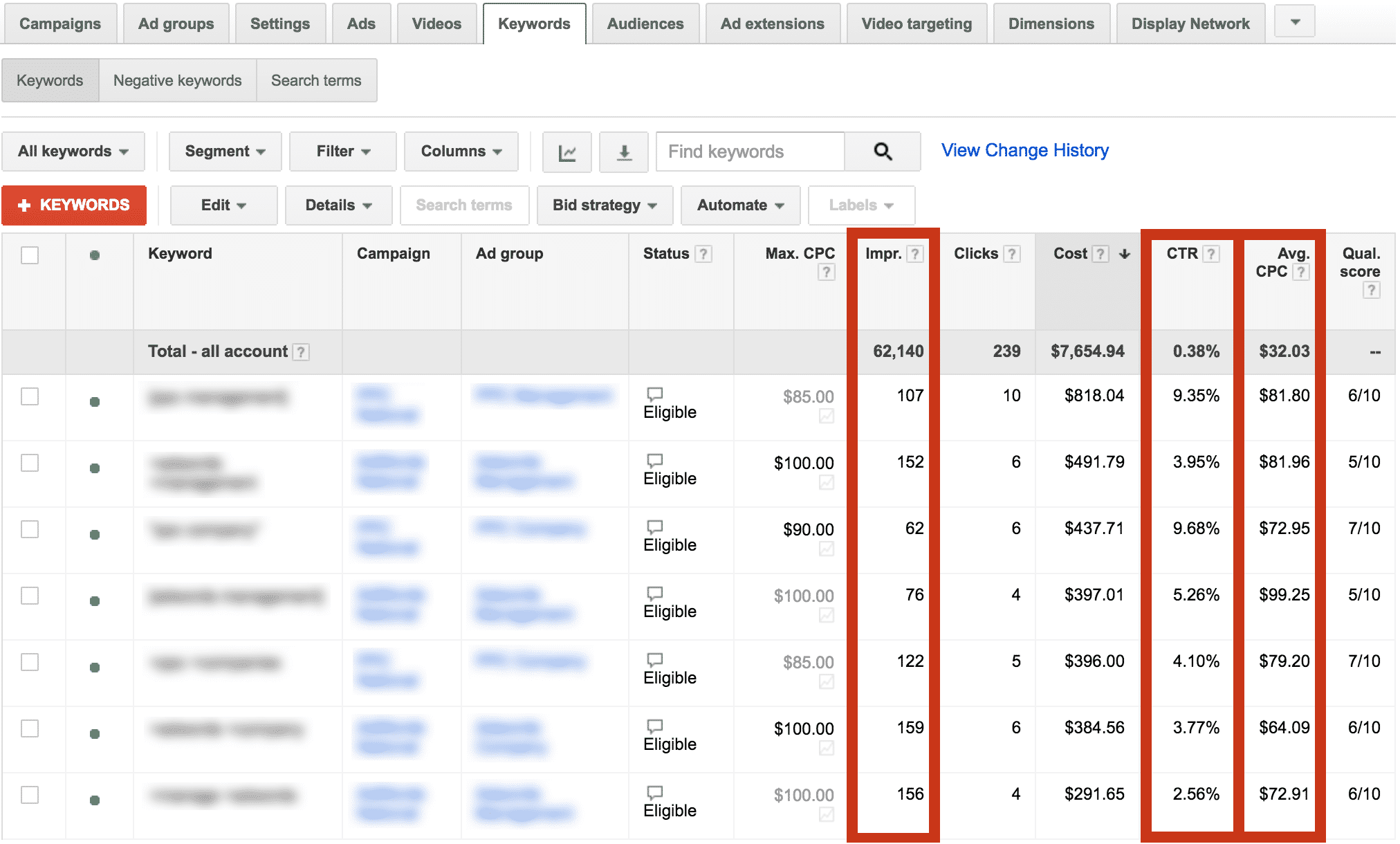Does Your PPC Contribution Margin Justify Your Ad Spend?
by Jacob Baadsgaard • June 2, 2016
Contribution margin is a key part of every business decision. Regardless of how big or small your business is, every investment needs to produce profitable dividends.
To put it simply, you need to make more than you spend.
PPC advertising is no different. Managing an effective PPC account takes time and money, both of which come at a cost.
But, the question is, is that cost worth it?
Determining Your PPC Account’s Contribution Margin
Regardless of whether you’re a seasoned PPC expert or a new business owner considering PPC advertising for the first time, it’s important to determine whether or not PPC actually makes sense for your business.
Fortunately, there’s a fairly straightforward way to see if PPC advertising works for your business. Basically, it all boils down to determining what your profitability threshold is.
In other words, how much revenue does each dollar of your marketing spend need to produce to make your business profitable?
In general, I like to use the following rule of thumb to predict when PPC advertising will make sense for a business:

Let’s take a look at this rule of thumb in more detail.
1x Contribution Margin
In this case, you are making $1 in revenue for every $1 you spend on PPC. On the surface, this looks like a breakeven equation, but the problem is, you have to spend money on a lot more than just marketing.
In most cases, you have fixed (rent, utilities, salaries, etc) and variable (materials, freight, commissions, etc) costs that need to be covered simply to break even.
So, if you’re only making $1 of revenue for every $1 you spend on PPC, you’re probably losing money hand-over-fist.
2x Contribution Margin
At a 2x multiple, you are spending $0.50 on PPC advertising to produce $1 in revenue.
This is definitely better than a 1x multiple, but for most companies that still means you are operating at a loss. Generally speaking, a healthy company has a profit margin of around 25%.
At a 25% profit margin, that means $0.75 of every dollar of revenue is going towards those fixed and variable costs we just discussed.
As you might imagine, if you spend $0.50 on PPC and $0.75 on fulfillment for every $1 in revenue, you’re gonna end losing a lot of money.
3x Contribution Margin
Once you hit a 3x multiple, the equation finally starts to make sense.
At first glance, this still looks like a losing scenario—you’re spending $0.33 on marketing and $0.75 on fulfillment for every $1 in revenue—but at this point, other factors start to come into play (referrals, branding…we’ll discuss these details in a bit).
As a result, most companies start to break even at about a 3x multiple.
Keep in mind, though, that this is still the break even point. Your company won’t grow at a 3x multiple, but at least you won’t be hemorrhaging money.
4x Contribution Margin
This is where most companies start to become profitable.
At this point, marketing, fulfillment and revenue all balance out and businesses can now turn a profit off of volume, referrals and other residual benefits from their marketing.
A 4x multiple makes PPC advertising profitable and sustainable, but it’s hard to grow a business on a 4x contribution margin.
For many companies, a 4x multiple is good enough. They don’t care about using PPC to become a huge enterprise, they simply want to keep their sales pipeline full and enjoy life.
However, if you really want to grow your company, your PPC contribution margin will need to be even higher.
5x Contribution Margin
Now things are really starting to make sense. At a 5x contribution margin, your PPC ad spend translates directly into profit.
As a result, the more you spend on PPC, the more profit you will make. You can then reinvest that profit into more PPC advertising, which produces even more profit.
Can you see where this is going?
Once companies break the 5x multiple mark, PPC advertising becomes a growth engine for their business.
I saw this happen firsthand with one of my earliest clients. We cut their cost-per-lead by 65%, pushing the contribution margin of their PPC advertising from 2x to 6x.
The company poured all of that surplus profit back into PPC advertising and grew by leaps and bounds. In fact, the biggest challenge became finding enough sales people to field the flood of qualified leads they were getting from PPC.
The company grew from around 25 employees to a staff of over 250 and made millions in additional profit (for the full story, click here).
Obviously, every business has different expenses, profit margins and marketing objectives that will affect these numbers. However, these rules of thumb are a remarkably good way to predict which marketing efforts will yield results.
Predicting PPC Success
Once you understand contribution margin, determining whether PPC is right for your business (or whether or not your PPC campaigns are producing value for your business) is a fairly simple exercise.
Honestly, if you are currently running PPC campaigns, you should probably conduct this exercise at least twice a year.
What You Need to Calculate Your Contribution Margin
To calculate the contribution margin for your PPC campaigns, you need 6 pieces of information:
- Impressions
- Estimated Average Cost-per-Click
- Estimated Clickthrough Rate
- Estimated Conversion Rate
- Estimated Close Rate
- Customer Lifetime Value
For example, here’s how you’d obtain that information for an AdWords campaign:
Impressions
This is fairly easy to obtain through AdWords.
If you’re new to paid search advertising, just open the Keyword Planner in AdWords and type in the keywords you believe people will type in if they are interested in your product or service. This will give you the search volume—or potential impressions—for your ads.
For example, here’s the search volume for the keyword “contribution margin.” It looks like there are about 33,100 monthly searches for this keyword.

If you are currently running an AdWords campaign, you can see what the search volume for your budget is by looking at the impressions count for your ads.
Estimated Average Cost-Per-Click (CPC)
Once you’ve entered your target keywords, the Keyword Planner will give also you an estimate of what you should bid on your keywords.
If you aren’t currently running an AdWords campaign, that’s probably as good as you can do on your own. However, if you talk to an educated marketer, you should be able to get even more insight into what the average CPC for your industry will be.
If you are already using AdWords, you can find your current average CPC in your keyword report.
Estimated Clickthrough Rate (CTR)
Here again, if you are currently advertising on AdWords, you can see your actual CTR in your keyword report (see previous screenshot).
However, if you haven’t advertised before, you may have to guess at what your clickthrough rate would be. To help you out, the average CTR for paid search advertising is 1.91%, although this varies by industry (to see average CTRs for a range of industries, click here).
That being said, the most educated guess will come from an experienced marketer, so if you are trying to decide if paid search is right for you, I’d recommend reaching out to someone with experience in the field (click here if you’d like us to walk you through this process).
Estimated Conversion Rate
Depending on your industry, traffic quality and how optimized your landing page is, your conversion rate will vary considerably.
If you are currently tracking conversions (whatever it is you want people to do after they click on your PPC ads), you should be able to find your conversion rate fairly easily. Just divide your total conversions by your total clicks!
If you’re new to paid search, you’ll have to estimate your conversion rate. After auditing over 2,000 AdWords accounts at Disruptive, we found that the average AdWords account has a conversion rate of 3.16%.
Here’s how conversion rates varied in our audits:
![]()
Since most accounts had a conversion rate of 0-4%, it’s probably safe to estimate that your traffic will convert somewhere in that range.
Estimated Close Rate
Your close rate is the percentage of conversions that become sales.
For example, if you have an eCommerce company, every conversion may be a sale (100% close rate). If your conversions are leads that you are passing to your sales team, your close rate will be much lower.
Hopefully, if you are doing paid search advertising, you are already tracking your campaigns from click-to-close. As a result, you should know exactly what your close rate is.
Unfortunately, most companies don’t have this level of tracking in place. So, whether you are new to paid search or simply haven’t fully implemented your tracking, you’ll probably have to estimate your lead close rate.
Customer Lifetime Value (LTV)
Your customer LTV is the average amount of revenue you collect from a customer.
For example, if you sell a $1,000 widget and never hear from that customer ever again, your LTV is $1,000.
On the other hand, if you have a subscription model that costs $50/month and your customers pay for an average of 8 months, your LTV is $400.
Calculating Your Contribution Margin
Now that we have all of this information, we just need to make a few quick calculations.
For the purposes of this analysis, we’ll assume an infinite budget. After all, if it works with a big budget, it will work with a smaller budget, right?
Step 1. Multiply Impressions and Estimated CTR to get your Total Clicks:
(33,100 impressions) x (1.91% CTR) = 632 clicks
Step 2. Multiply your Estimated Average CPC by your Total Clicks to get your Campaign Cost.
($4.05 average CPC) x (632 clicks) = $2,560 cost
Step 3. Multiply your Total Clicks by your Estimated Conversion Rate to get your Total Conversions.
(632 clicks) x (3.19% conversion rate) = 20 conversions
Step 4. Divide your Campaign Cost by your Total Conversions to get your Cost-per-Conversion.
($2,560) / (20 conversions) = $128 per conversion
Step 5. Divide your Cost-per-Conversion by your Estimated Close Rate to get your Cost-per-Sale.
($128 per conversion) / (20% close rate) = $640 per sale
Step 6. Divide your Customer LTV by your Cost-per-Sale to determine your contribution margin!
($2,000 LTV) / ($640 per sale) = 3.15x contribution margin
Based on these figures, this PPC campaign produces $3.15 in revenue for every dollar spent on advertising.
At the moment, it’s probably around the break even point, but with a little tweaking, it could probably become quite profitable.
Accounting for “Invisible” Revenue
If you think about these numbers, this company’s 3.15x contribution margin doesn’t seem like a break even scenario.
After all, if this company spend 75% of its revenue on fulfillment, that means that they are spending $2.35 on fulfillment and $1.00 on advertising. They are spending $3.35 to produce $3.15 in revenue.
In other words, they are losing money!
This is where the “invisible” marketing perks like referrals and branding come into play.
After working with hundreds of clients, I’ve found that you can typically account for referrals and other hidden advertising benefits by multiplying your customer LTV by 1.5.
Let’s take a look at what happens in this scenario when we account for this “bonus” revenue.
($3,000 LTV) / ($640 per sale) = $4.69 in revenue per $1.00 in advertising spend.
Now, if the company spends 75% of its revenue on fulfillment, they spend $3.52 on fulfillment and $1.00 on advertising. That means they are spending $4.52 and making $4.69.
Suddenly, they’re breaking even!
This is why a 3x contribution margin is usually the the break even point for most businesses. In the strictest terms, a 3x contribution margin doesn’t cut it, but when you account for the hidden benefits of PPC advertising, the equation starts to make sense.
Making Your Life Easier
To help you run this calculation, here is a quick way you can use Excel to calculate your contribution margin.
Simply set up your table like this (filling in the appropriate cells with your own values, of course):

Paste the following formula into cell A8.
=A6/((A1*A3*A2)/(A1*A3*A4)/A5)
The formula will spit out your contribution margin.
Using this formula, you can tweak your numbers and come up with some best case, worst case and most likely case scenarios. If the numbers make sense, PPC advertising is probably a good fit for your company.
This formula should work for any type of PPC advertising (paid social promotion, display advertising, paid search, etc).
As long as you can come up with realistic estimates for each value, this calculation should give you a good feel for whether or not a particular marketing channel is worth your money.
Conclusion
The success or failure of your PPC advertising depends on whether or not your marketing efforts have a viable contribution margin.
If your advertising is producing at least $4 of revenue per $1 of ad spend, you are probably making a profit. If you are driving less than $3 of revenue per $1 of ad spend, your campaigns need some serious work.
Similarly, if you are considering PPC advertising (or any other new marketing channel), this exercise can help you decide what your odds of success are.
If the numbers don’t add up, it’s not worth the investment. If they do, PPC can make your business incredibly profitable.
By the way, if you’d like me to look at your business and help you decide if PPC advertising is worth the money, let me know here or in the comments.
Do you agree with this approach? Do these numbers make sense to you? How do you use (or plan to use) contribution margin to guide your marketing decisions?






